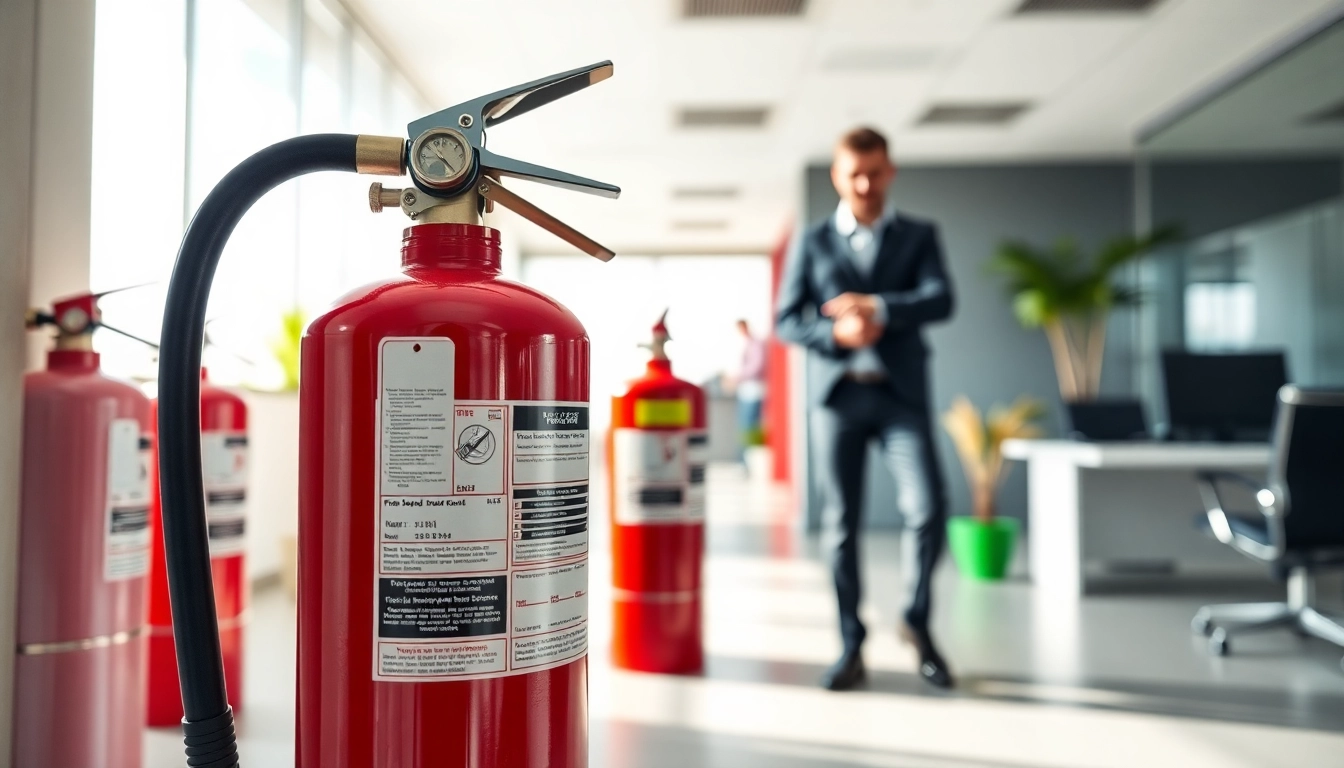
Understanding the Importance of Fire Extinguisher Checks
Fire extinguishers are critical components of fire safety in both residential and commercial settings. Regular fire extinguisher checks ensure that these devices are ready when needed, helping to protect lives and property from the devastating effects of fire. This necessity cannot be overstated, as fire safety regulations and personal responsibility converge to advocate for consistent inspections and maintenance.
Why Regular Inspections Matter
Regular inspections of fire extinguishers serve multiple purposes. Firstly, they ensure that the extinguishers are in good working order, which is essential in emergency situations. A well-maintained unit can significantly increase the chances of successfully extinguishing a fire before it escalates.
Moreover, routine inspections promote safety awareness. They remind property owners and occupants of their responsibilities regarding safety measures, reinforcing the culture of preparedness. Inspections also verify that the extinguishers are not only operational but also suitable for the types of fires that might occur in a given area.
Legal Requirements and Compliance
In many jurisdictions, the law mandates regular inspections of fire extinguishers as part of fire safety regulations. For example, the National Fire Protection Association (NFPA) stipulates in its standard NFPA 10 that fire extinguishers must be inspected monthly by a trained individual and undergo more comprehensive maintenance annually. Failing to comply with these regulations can result in legal repercussions, including fines, and more importantly, can endanger lives.
Businesses, especially those open to the public or housing flammable materials, can significantly increase their liability if they neglect fire protection measures; hence the enforcement of such regulations. Staying compliant protects not only the individuals and property involved but also minimizes potential legal liabilities.
The Risks of Neglecting Inspections
Neglecting fire extinguisher checks can lead to catastrophic consequences. Fire extinguishers that are not regularly maintained may fail to operate when needed, potentially resulting in severe property damage or loss of life. Furthermore, the lack of maintenance might give a false sense of security, leading individuals to underestimate fire risks.
Moreover, the costs of neglect—both in lost property and increased liability—far outweigh the minimal time and resources required for routine inspections. Ignoring these checks not only risks physical property but also can destroy the trust and reputation of a business or owner in the community.
Steps for Effective Fire Extinguisher Checks
Monthly Visual Inspection Techniques
Conducting a visual inspection is the first step in ensuring the effectiveness of a fire extinguisher. This should be done monthly and involves several key checks:
- Location: Ensure that the extinguisher is located in its designated spot, free from obstructions. It should be easily accessible to everyone in case of emergency.
- Physical Condition: Visually examine the extinguisher for signs of wear, dents, rust, or any physical damage that may affect performance.
- Pressure Gauge: Check the pressure gauge, ensuring it is within the recommended range. A green indicator signifies that the extinguisher is operational.
- Inspection Tag: Verify that the extinguisher has a current inspection tag indicating that it has undergone a professional examination within the last year.
Detailed Annual Maintenance Procedures
In addition to monthly inspections, thorough annual maintenance checks should be performed by a qualified professional. This maintenance includes:
- Recharging: If the extinguisher has been used, it must be recharged immediately to restore its effectiveness.
- Internal Examination: Professionals will inspect the interior components of the extinguisher to check for corrosion and to ensure that all parts are functioning correctly.
- Hydrostatic Testing: Depending on local regulations, fire extinguishers may require hydrostatic testing every five or twelve years to ensure their integrity and safety during use.
Identifying Signs of Wear or Damage
Knowing how to identify signs of wear or damage can save lives. Common issues to inspect for include:
- Corrosion or rust on the exterior.
- Cracks or bulges in the cylinder.
- Damaged hoses or nozzles.
- Loss of pressure, indicated by the pressure gauge.
Promptly addressing any signs of wear or damage by contacting a professional helps ensure that the fire extinguisher remains functional when needed.
Choosing the Right Fire Extinguisher for Your Needs
Types of Fire Extinguishers Explained
Understanding the different types of fire extinguishers is vital. They are categorized based on the classes of fires they are designed to combat:
- A Class: For ordinary combustible materials like wood, paper, and cloth.
- B Class: For flammable liquids and gasses like gasoline or oils.
- C Class: For electrical fires.
- D Class: For combustible metals such as magnesium or titanium.
- K Class: Specifically for kitchen fires involving cooking oils and fats.
Selecting the correct type for your environment is essential to ensuring effective suppression during a fire emergency.
How to Determine Your Fire Safety Requirements
To adequately assess your fire safety requirements, consider the following:
- Identify Potential Hazards: Evaluate your property and the types of activities conducted that may pose fire risks.
- Consult Local Regulations: Fire codes vary; ensure compliance with local laws regarding fire safety equipment.
- Provide Adequate Coverage: Ensure that the number of extinguishers and their locations cover all areas where a fire might originate.
Best Practices for Placement and Accessibility
The placement of fire extinguishers is crucial. They should be visible, accessible, and strategically placed throughout a property:
- Install extinguishers on walls, about four feet off the ground.
- Ensure that they are not obstructed by furniture or other items.
- Place extinguishers near exit points to guide users toward safety.
Conduct regular training sessions to familiarize all occupants with the locations and functionalities of the extinguishers.
Who Can Perform Fire Extinguisher Checks?
DIY vs. Professional Inspections
Many property owners wonder whether fire extinguisher checks can be performed independently. While visual inspections can be conducted by anyone, a qualified technician must perform the detailed annual inspections and maintenance. This distinction is critical to ensure safety and compliance with fire codes.
Homeowners should feel empowered to conduct monthly visual checks, but for anything beyond that, especially involving internal inspection or hydrostatic testing, consulting a certified professional is imperative.
Finding Certified Inspectors in Your Area
To find certified inspectors, consider the following steps:
- Search online for fire safety companies that offer inspection services.
- Check if they are certified by relevant organizations, such as the National Fire Protection Association (NFPA).
- Request references or read online reviews to assess their reliability and service quality.
Building a relationship with a reputable inspection service can help streamline maintenance and inspections over time.
Costs Associated with Fire Safety Services
The costs for fire extinguisher inspections can vary based on several factors, including the size of the facility and the number of extinguishers:
- Monthly visual inspections are often low-cost or included if done by internal staff.
- Annual professional inspections can range from $15 to $30 per extinguisher.
- Hydrostatic testing may incur additional charges, typically between $30 and $60, depending on the type and size of extinguisher.
While these expenses represent a small fraction of fire safety budgets, avoiding them can lead to far greater costs in the case of a fire emergency.
Common Questions About Fire Extinguisher Checks
How Often Should You Check Your Extinguishers?
The NFPA recommends that fire extinguishers be visually checked on a monthly basis. It’s also advisable to have them inspected by a professional at least once a year to satisfy compliance regulations and ensure operational effectiveness.
What Are the Inspection Requirements?
Inspection requirements vary based on local laws, but generally, they include monthly visual checks and annual professional inspections. Compliance with NFPA standards is often a benchmark for many jurisdictions.
Understanding Hydrostatic Testing Intervals
Hydrostatic testing is vital for understanding the integrity of the extinguisher. Generally, periodic testing is required every five to twelve years depending on the type of extinguisher and local regulations. This testing assesses whether the cylinder can handle pressure without leaking or bursting.






